牛津译林版(2019)选择性必修 第一册Unit 3 The art of painting Chinese Painting 中国绘画课件(共30张PPT)
文档属性
| 名称 | 牛津译林版(2019)选择性必修 第一册Unit 3 The art of painting Chinese Painting 中国绘画课件(共30张PPT) |  | |
| 格式 | pptx | ||
| 文件大小 | 1.0MB | ||
| 资源类型 | 教案 | ||
| 版本资源 | 牛津译林版(2019) | ||
| 科目 | 英语 | ||
| 更新时间 | 2023-11-28 20:57:08 | ||
图片预览

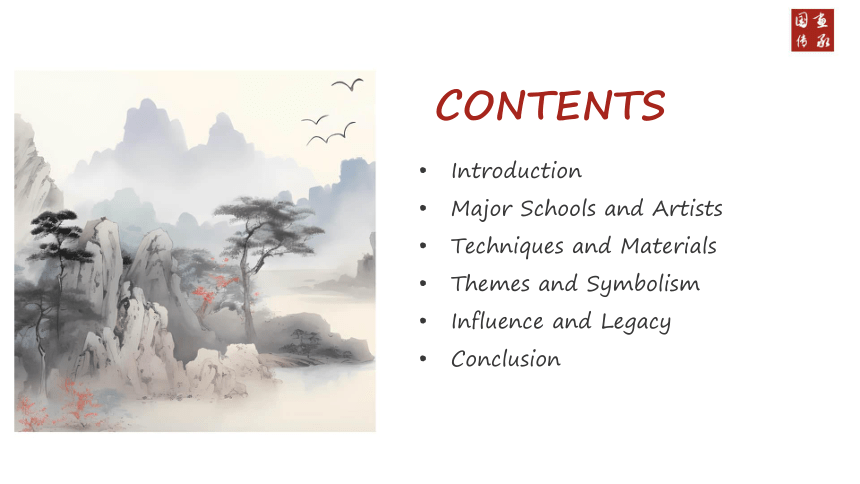
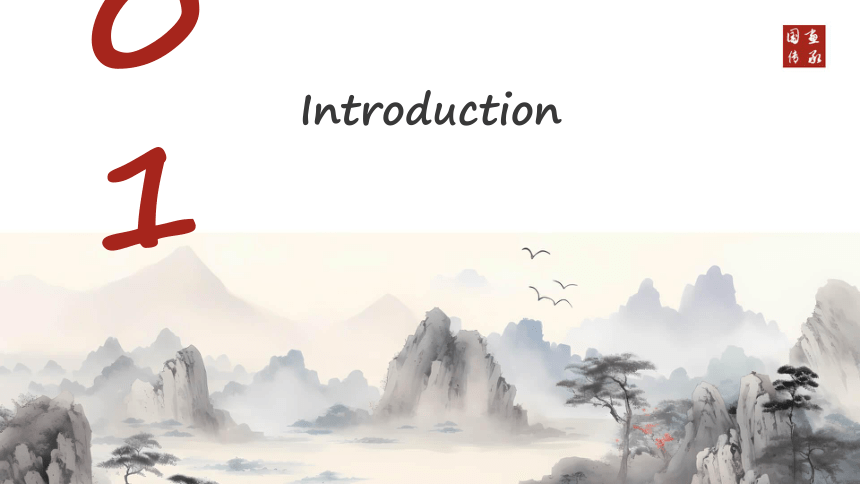
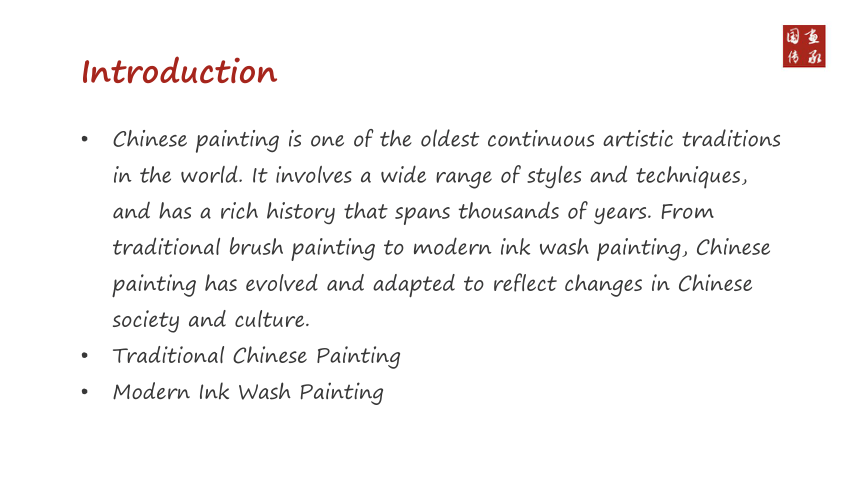
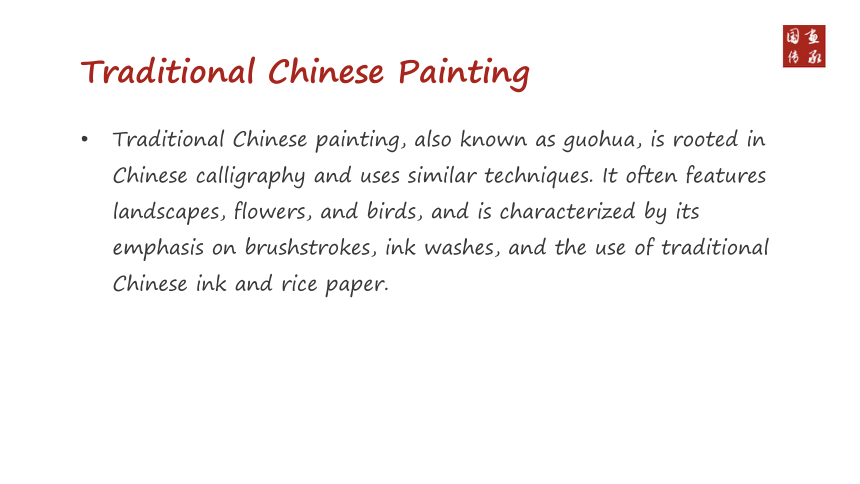
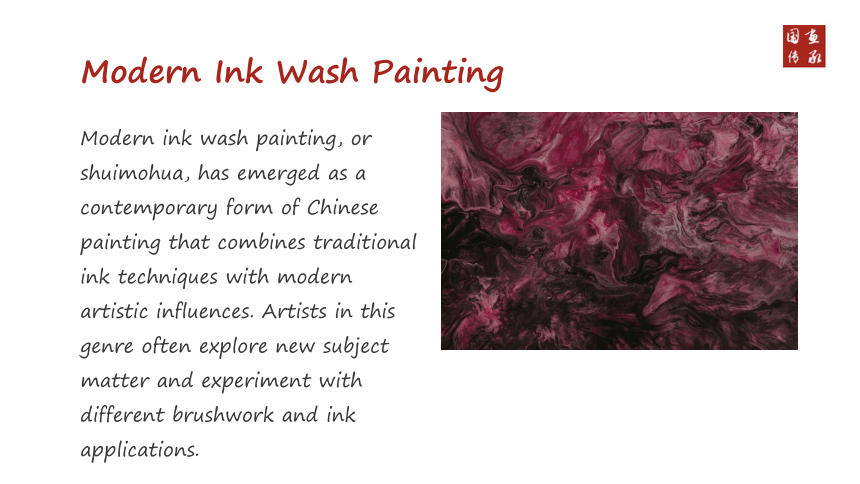
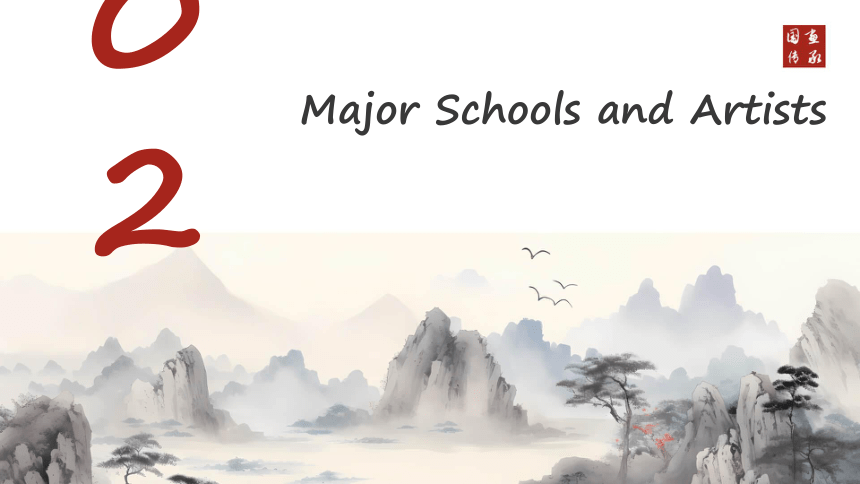
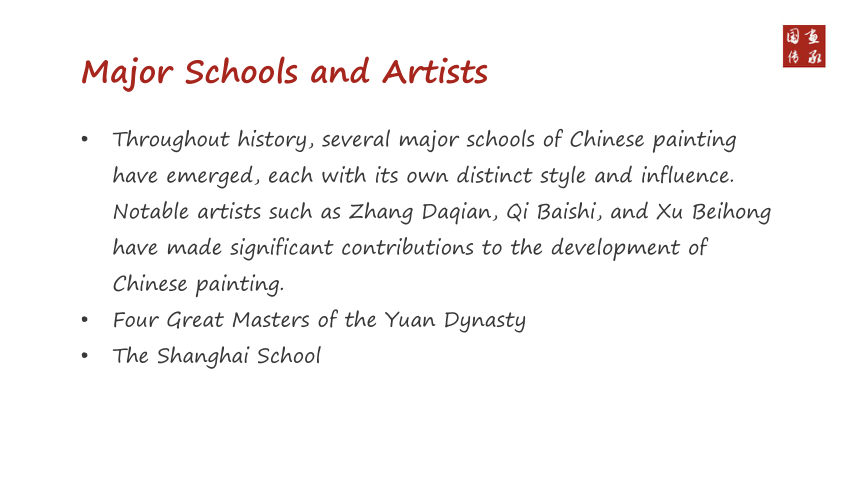
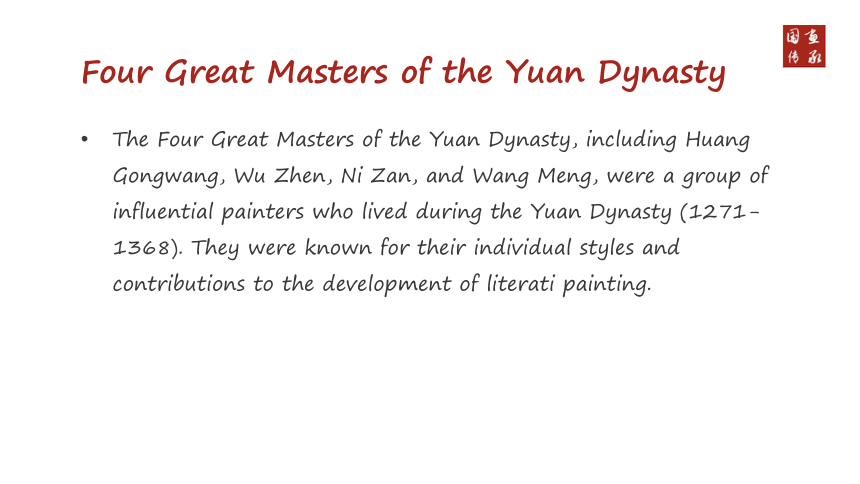
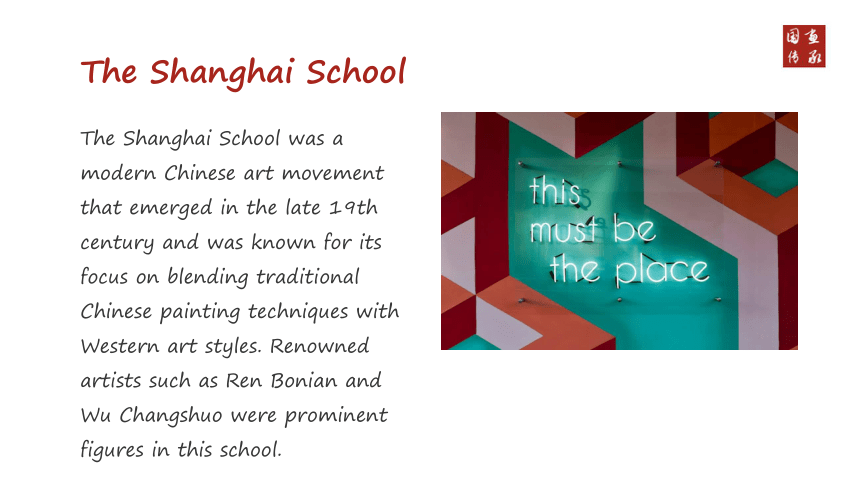
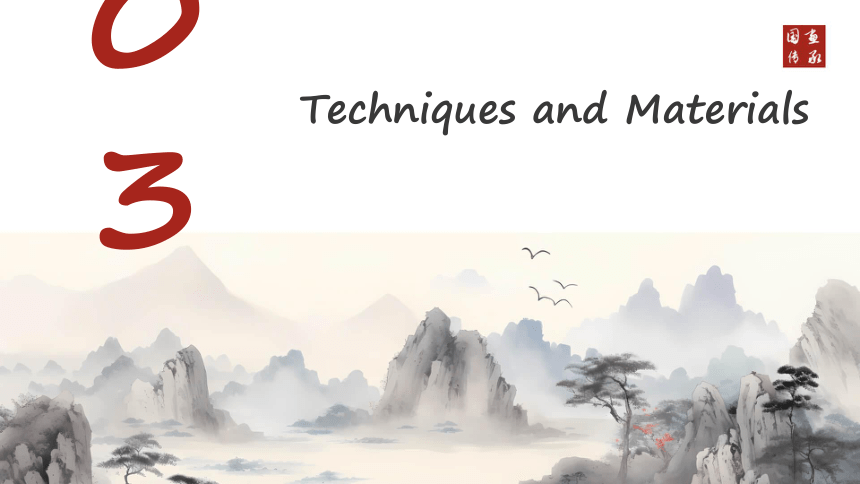
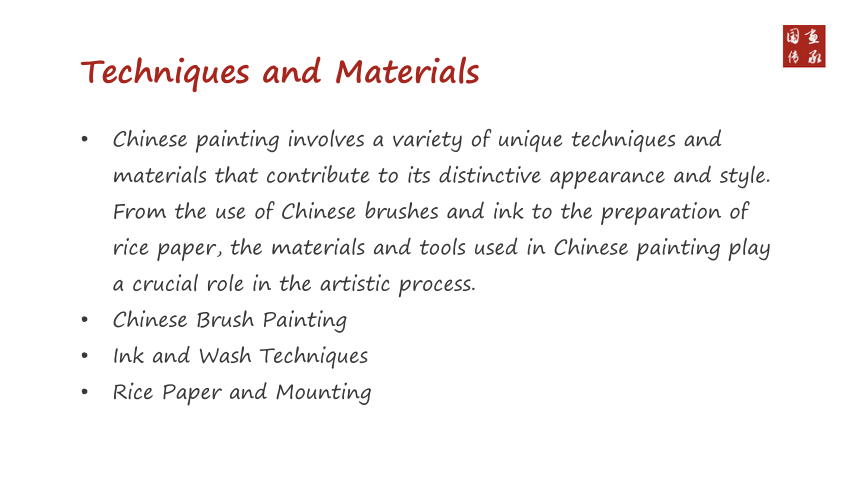
文档简介
(共30张PPT)
Chinese Painting
ZOE111
2023-11-28
CONTENTS
Introduction
Major Schools and Artists
Techniques and Materials
Themes and Symbolism
Influence and Legacy
Conclusion
01
Introduction
Introduction
Chinese painting is one of the oldest continuous artistic traditions in the world. It involves a wide range of styles and techniques, and has a rich history that spans thousands of years. From traditional brush painting to modern ink wash painting, Chinese painting has evolved and adapted to reflect changes in Chinese society and culture.
Traditional Chinese Painting
Modern Ink Wash Painting
Traditional Chinese Painting
Traditional Chinese painting, also known as guohua, is rooted in Chinese calligraphy and uses similar techniques. It often features landscapes, flowers, and birds, and is characterized by its emphasis on brushstrokes, ink washes, and the use of traditional Chinese ink and rice paper.
Modern Ink Wash Painting
Modern ink wash painting, or shuimohua, has emerged as a contemporary form of Chinese painting that combines traditional ink techniques with modern artistic influences. Artists in this genre often explore new subject matter and experiment with different brushwork and ink applications.
02
Major Schools and Artists
Major Schools and Artists
Throughout history, several major schools of Chinese painting have emerged, each with its own distinct style and influence. Notable artists such as Zhang Daqian, Qi Baishi, and Xu Beihong have made significant contributions to the development of Chinese painting.
Four Great Masters of the Yuan Dynasty
The Shanghai School
Four Great Masters of the Yuan Dynasty
The Four Great Masters of the Yuan Dynasty, including Huang Gongwang, Wu Zhen, Ni Zan, and Wang Meng, were a group of influential painters who lived during the Yuan Dynasty (1271-1368). They were known for their individual styles and contributions to the development of literati painting.
The Shanghai School
The Shanghai School was a modern Chinese art movement that emerged in the late 19th century and was known for its focus on blending traditional Chinese painting techniques with Western art styles. Renowned artists such as Ren Bonian and Wu Changshuo were prominent figures in this school.
03
Techniques and Materials
Techniques and Materials
Chinese painting involves a variety of unique techniques and materials that contribute to its distinctive appearance and style. From the use of Chinese brushes and ink to the preparation of rice paper, the materials and tools used in Chinese painting play a crucial role in the artistic process.
Chinese Brush Painting
Ink and Wash Techniques
Rice Paper and Mounting
Chinese Brush Painting
Chinese brush painting, or guohua, relies on special brushes made from animal hair and bamboo handles. The brushes are used to create a wide range of brushstrokes, from fine lines to bold strokes, and are essential for capturing the expressive qualities of traditional Chinese painting.
Ink and Wash Techniques
The use of ink and wash techniques is a fundamental aspect of Chinese painting. Artists use various dilutions of ink to create gradations of light and dark, as well as different textures and effects. The combination of ink and water creates a unique aesthetic that is synonymous with Chinese painting.
Rice Paper and Mounting
Rice paper, or xuan paper, is a vital component of Chinese painting. It is prized for its ability to absorb ink and retain brushstrokes, resulting in nuanced and expressive renderings. Additionally, the traditional mounting of Chinese paintings on silk or paper scrolls is a defining feature of the art form.
04
Themes and Symbolism
Themes and Symbolism
Chinese painting often incorporates specific themes and symbolism that hold cultural and philosophical significance. From depictions of nature and the natural world to symbolic representations of virtues and emotions, these themes contribute to the deeper meaning and interpretation of Chinese paintings.
Nature and Landscapes
Symbolic Imagery
Figure Painting and Portraiture
Nature and Landscapes
The depiction of natural landscapes, including mountains, rivers, and forests, holds symbolic significance in Chinese painting. These scenes are often imbued with philosophical and poetic connotations, reflecting the harmony between humanity and nature.
Symbolic Imagery
Chinese painting frequently utilizes symbolic imagery to convey deeper meanings. Symbols such as the lotus flower, which represents purity and enlightenment, and the pine tree, which symbolizes longevity and resilience, are commonly found in Chinese paintings.
Figure Painting and Portraiture
Figure painting and portraiture are also prominent themes in Chinese painting. Artists often depict historical figures, legendary heroes, and everyday people, capturing their emotions, actions, and societal roles within the context of Chinese culture and history.
05
Influence and Legacy
Influence and Legacy
The influence of Chinese painting has extended far beyond the borders of China, impacting the artistic traditions of neighboring countries and inspiring artists around the world. Its enduring legacy is evident in the continued appreciation and study of Chinese painting as a revered and celebrated art form.
International Influence
Contemporary Impact
Preservation and Appreciation
International Influence
Chinese painting has significantly influenced the artistic practices of neighboring countries such as Japan, Korea, and Vietnam. Elements of Chinese painting, including brush techniques, ink applications, and thematic concepts, have been incorporated into the art traditions of these regions.
Contemporary Impact
In the contemporary art world, Chinese painting continues to inspire artists and scholars, serving as a source of creative exploration and cultural exchange. Contemporary Chinese artists infuse traditional painting techniques with modern perspectives, contributing to the ongoing evolution of the art form.
Preservation and Appreciation
Efforts to preserve and promote the appreciation of Chinese painting have been ongoing, both within China and on the global stage. Museums, galleries, and educational institutions play a vital role in showcasing and educating the public about the rich history and diversity of Chinese painting.
06
Conclusion
Conclusion
Chinese painting stands as a testament to the enduring artistic traditions and cultural heritage of China. Its diverse styles, themes, and techniques continue to captivate audiences and scholars, fostering a deep appreciation for the beauty and depth of Chinese art.
Embracing Tradition and Innovation
Continued Exploration
Embracing Tradition and Innovation
As Chinese painting evolves and adapts to contemporary contexts, it remains a potent source of creative inspiration and cultural expression. By embracing both tradition and innovation, Chinese painting continues to thrive as a vibrant and influential art form.
Continued Exploration
The exploration of Chinese painting, its techniques, and its symbolic meanings invites continued scholarly inquiry and artistic exploration. As the global community engages with Chinese painting, new perspectives and interpretations emerge, ensuring its relevance for generations to come.
THE END
THANKS
Chinese Painting
ZOE111
2023-11-28
CONTENTS
Introduction
Major Schools and Artists
Techniques and Materials
Themes and Symbolism
Influence and Legacy
Conclusion
01
Introduction
Introduction
Chinese painting is one of the oldest continuous artistic traditions in the world. It involves a wide range of styles and techniques, and has a rich history that spans thousands of years. From traditional brush painting to modern ink wash painting, Chinese painting has evolved and adapted to reflect changes in Chinese society and culture.
Traditional Chinese Painting
Modern Ink Wash Painting
Traditional Chinese Painting
Traditional Chinese painting, also known as guohua, is rooted in Chinese calligraphy and uses similar techniques. It often features landscapes, flowers, and birds, and is characterized by its emphasis on brushstrokes, ink washes, and the use of traditional Chinese ink and rice paper.
Modern Ink Wash Painting
Modern ink wash painting, or shuimohua, has emerged as a contemporary form of Chinese painting that combines traditional ink techniques with modern artistic influences. Artists in this genre often explore new subject matter and experiment with different brushwork and ink applications.
02
Major Schools and Artists
Major Schools and Artists
Throughout history, several major schools of Chinese painting have emerged, each with its own distinct style and influence. Notable artists such as Zhang Daqian, Qi Baishi, and Xu Beihong have made significant contributions to the development of Chinese painting.
Four Great Masters of the Yuan Dynasty
The Shanghai School
Four Great Masters of the Yuan Dynasty
The Four Great Masters of the Yuan Dynasty, including Huang Gongwang, Wu Zhen, Ni Zan, and Wang Meng, were a group of influential painters who lived during the Yuan Dynasty (1271-1368). They were known for their individual styles and contributions to the development of literati painting.
The Shanghai School
The Shanghai School was a modern Chinese art movement that emerged in the late 19th century and was known for its focus on blending traditional Chinese painting techniques with Western art styles. Renowned artists such as Ren Bonian and Wu Changshuo were prominent figures in this school.
03
Techniques and Materials
Techniques and Materials
Chinese painting involves a variety of unique techniques and materials that contribute to its distinctive appearance and style. From the use of Chinese brushes and ink to the preparation of rice paper, the materials and tools used in Chinese painting play a crucial role in the artistic process.
Chinese Brush Painting
Ink and Wash Techniques
Rice Paper and Mounting
Chinese Brush Painting
Chinese brush painting, or guohua, relies on special brushes made from animal hair and bamboo handles. The brushes are used to create a wide range of brushstrokes, from fine lines to bold strokes, and are essential for capturing the expressive qualities of traditional Chinese painting.
Ink and Wash Techniques
The use of ink and wash techniques is a fundamental aspect of Chinese painting. Artists use various dilutions of ink to create gradations of light and dark, as well as different textures and effects. The combination of ink and water creates a unique aesthetic that is synonymous with Chinese painting.
Rice Paper and Mounting
Rice paper, or xuan paper, is a vital component of Chinese painting. It is prized for its ability to absorb ink and retain brushstrokes, resulting in nuanced and expressive renderings. Additionally, the traditional mounting of Chinese paintings on silk or paper scrolls is a defining feature of the art form.
04
Themes and Symbolism
Themes and Symbolism
Chinese painting often incorporates specific themes and symbolism that hold cultural and philosophical significance. From depictions of nature and the natural world to symbolic representations of virtues and emotions, these themes contribute to the deeper meaning and interpretation of Chinese paintings.
Nature and Landscapes
Symbolic Imagery
Figure Painting and Portraiture
Nature and Landscapes
The depiction of natural landscapes, including mountains, rivers, and forests, holds symbolic significance in Chinese painting. These scenes are often imbued with philosophical and poetic connotations, reflecting the harmony between humanity and nature.
Symbolic Imagery
Chinese painting frequently utilizes symbolic imagery to convey deeper meanings. Symbols such as the lotus flower, which represents purity and enlightenment, and the pine tree, which symbolizes longevity and resilience, are commonly found in Chinese paintings.
Figure Painting and Portraiture
Figure painting and portraiture are also prominent themes in Chinese painting. Artists often depict historical figures, legendary heroes, and everyday people, capturing their emotions, actions, and societal roles within the context of Chinese culture and history.
05
Influence and Legacy
Influence and Legacy
The influence of Chinese painting has extended far beyond the borders of China, impacting the artistic traditions of neighboring countries and inspiring artists around the world. Its enduring legacy is evident in the continued appreciation and study of Chinese painting as a revered and celebrated art form.
International Influence
Contemporary Impact
Preservation and Appreciation
International Influence
Chinese painting has significantly influenced the artistic practices of neighboring countries such as Japan, Korea, and Vietnam. Elements of Chinese painting, including brush techniques, ink applications, and thematic concepts, have been incorporated into the art traditions of these regions.
Contemporary Impact
In the contemporary art world, Chinese painting continues to inspire artists and scholars, serving as a source of creative exploration and cultural exchange. Contemporary Chinese artists infuse traditional painting techniques with modern perspectives, contributing to the ongoing evolution of the art form.
Preservation and Appreciation
Efforts to preserve and promote the appreciation of Chinese painting have been ongoing, both within China and on the global stage. Museums, galleries, and educational institutions play a vital role in showcasing and educating the public about the rich history and diversity of Chinese painting.
06
Conclusion
Conclusion
Chinese painting stands as a testament to the enduring artistic traditions and cultural heritage of China. Its diverse styles, themes, and techniques continue to captivate audiences and scholars, fostering a deep appreciation for the beauty and depth of Chinese art.
Embracing Tradition and Innovation
Continued Exploration
Embracing Tradition and Innovation
As Chinese painting evolves and adapts to contemporary contexts, it remains a potent source of creative inspiration and cultural expression. By embracing both tradition and innovation, Chinese painting continues to thrive as a vibrant and influential art form.
Continued Exploration
The exploration of Chinese painting, its techniques, and its symbolic meanings invites continued scholarly inquiry and artistic exploration. As the global community engages with Chinese painting, new perspectives and interpretations emerge, ensuring its relevance for generations to come.
THE END
THANKS
同课章节目录
- Unit 1 Food matters
- Welcome to the unit
- Reading
- Grammar and usage
- Integrated skills
- Extended reading
- Project
- Unit 2 The Universal Language
- Welcome to the unit
- Reading
- Grammar and usage
- Integrated skills
- Extended reading
- Project
- Unit 3 The art of painting
- Welcome to the unit
- Reading
- Grammar and usage
- Integrated skills
- Extended reading
- Project
- Unit 4 Exploring poetry
- Welcome to the unit
- Reading
- Grammar and usage
- Integrated skills
- Extended reading
- Project
